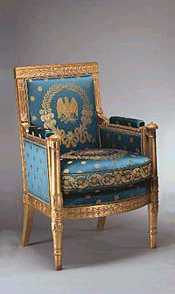
Bergère
Encyclopedia

Armchair
An armchair is a chair with arm rests.Armchair may also refer to:*Armchair nanotube, a carbon nanotube with chiral symmetry*Armchair, a sitting sex position*Armchair , a bus operator in London...
(fauteuil
Fauteuil
A fauteuil is a style of open-arm chair with a primarily exposed wooden frame originating in France in the early 18th century. A fauteuil is made of wood, and frequently with carved relief ornament. It is typically upholstered on the seat, the seat back and on the arms . Some fauteuils have a...
) with an upholstered
Upholstery
Upholstery is the work of providing furniture, especially seats, with padding, springs, webbing, and fabric or leather covers. The word upholstery comes from the Middle English word upholder, which referred to a tradesman who held up his goods. The term is equally applicable to domestic,...
back and armrest
Armrest
In an automotive context, an armrest is a feature found in many modern vehicles on which occupants can rest their arms. Armrests are also found on chairs in general.Armrests are more prolific in larger, more expensive models of car....
s on upholstered frames. The seat frame is over-upholstered, but the rest of the wooden framing is exposed: it may be moulded
Molding (decorative)
Molding or moulding is a strip of material with various profiles used to cover transitions between surfaces or for decoration. It is traditionally made from solid milled wood or plaster but may be made from plastic or reformed wood...
or carved
Wood carving
Wood carving is a form of working wood by means of a cutting tool in one hand or a chisel by two hands or with one hand on a chisel and one hand on a mallet, resulting in a wooden figure or figurine, or in the sculptural ornamentation of a wooden object...
, and of beech
Beech
Beech is a genus of ten species of deciduous trees in the family Fagaceae, native to temperate Europe, Asia and North America.-Habit:...
, painted or gilded
Gilding
The term gilding covers a number of decorative techniques for applying fine gold leaf or powder to solid surfaces such as wood, stone, or metal to give a thin coating of gold. A gilded object is described as "gilt"...
, or of fruitwood, walnut or mahogany with a waxed finish. Padded elbowrests may stand upon the armrests. A bergère is fitted with a loose, but tailored, seat cushion. It is designed for lounging in comfort, with a deeper, wider seat than that of a regular fauteuil, though the bergères by Bellangé
Pierre-Antoine Bellange
Pierre-Antoine Bellangé was a French ébéniste working in Paris. Bellangé held an eminent position among the representatives of the decorative arts at the beginning of the nineteenth century. He gained his master craftsman title on October 24, 1788...
in the White House (one illustrated) are more formal. A bergère in the eighteenth century was essentially a meuble courant, designed to be moved about to suit convenience, rather than being ranged permanently formally along the walls as part of the decor.
The fanciful name, "shepherdess chair", was coined in mid-eighteenth century Paris
Paris
Paris is the capital and largest city in France, situated on the river Seine, in northern France, at the heart of the Île-de-France region...
, where the model developed without a notable break from the late-seventeenth century chaise de commodité, a version of the wing chair
Wing chair
A "wing chair" is an easy chair or club chair with "wings" mounted to the back of the chair typically but not always stretching down to the arm rest...
, whose upholstered "wings" shielding the face from fireplace heat or from draughts were retained in the bergère à oreilles ("with ears"), or, fancifully, bergère confessionale, as if the occupant were hidden from view, as in a confessional
Confessional
A confessional is a small, enclosed booth used for the Sacrament of Penance, often called confession, or Reconciliation. It is the usual venue for the sacrament in the Roman Catholic Church, but similar structures are also used in Anglican churches of an Anglo-Catholic orientation, and also in the...
. A bergère may have a flat, raked back, in which case it is à la reine, or, more usually in Louis XV furnishings, it has a coved back, en cabriolet. A bergère with a low coved back that sweeps without a break into the armrests is a marquise.
Appearing first in Paris during the Régence
Régence
The Régence is the period in French history between 1715 and 1723, when King Louis XV was a minor and the land was governed by a Regent, Philippe d'Orléans, the nephew of Louis XIV of France....
(1715–23), the form reaches its full development in the unifying curves of the rococo
Rococo
Rococo , also referred to as "Late Baroque", is an 18th-century style which developed as Baroque artists gave up their symmetry and became increasingly ornate, florid, and playful...
style, then continues in a more architectural rectilinear style in the Louis XVI, Directoire
Directoire style
Directoire style, , describes a period in the decorative arts, fashion, and especially furniture design, concurrent with the post-Revolution French Directory...
, and French and American Empire styles.

